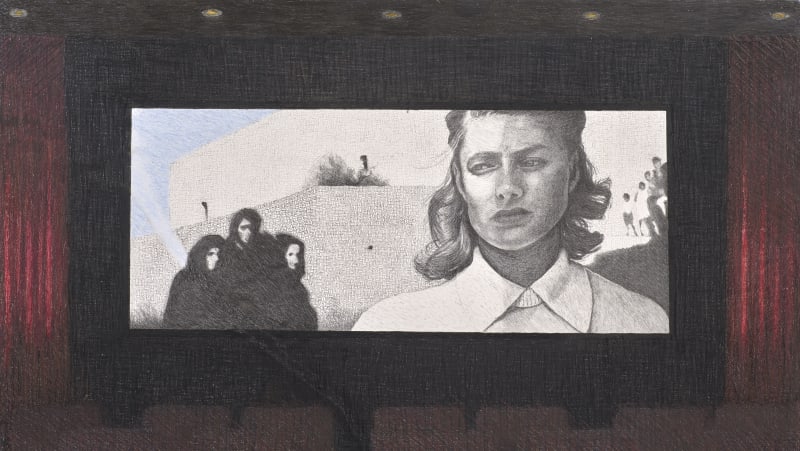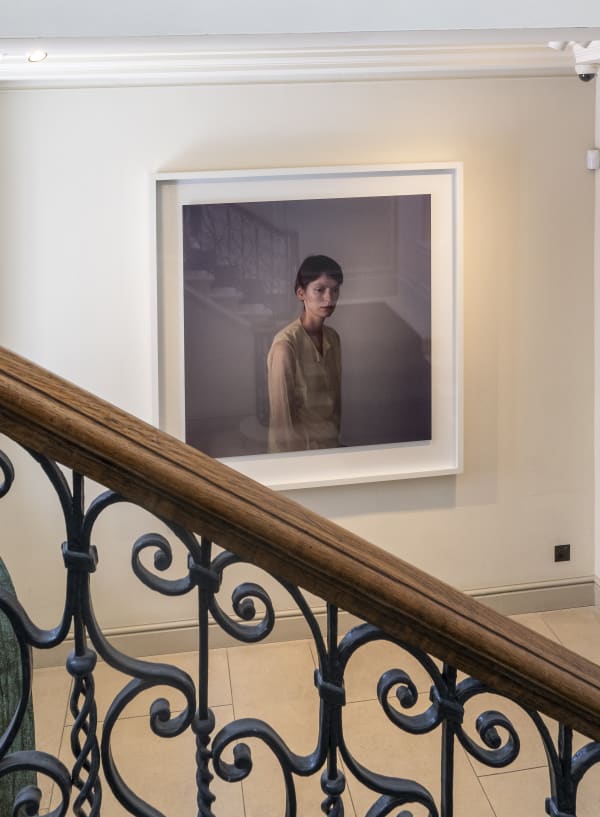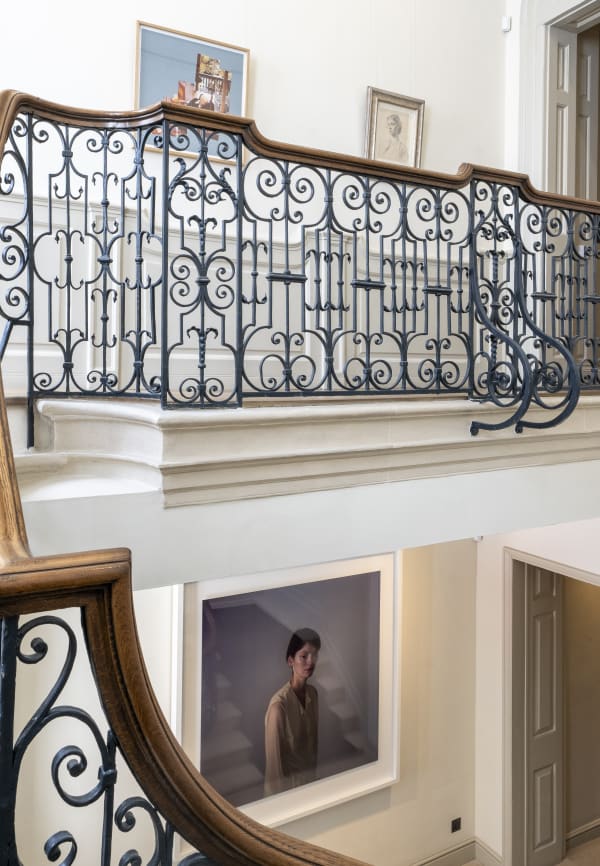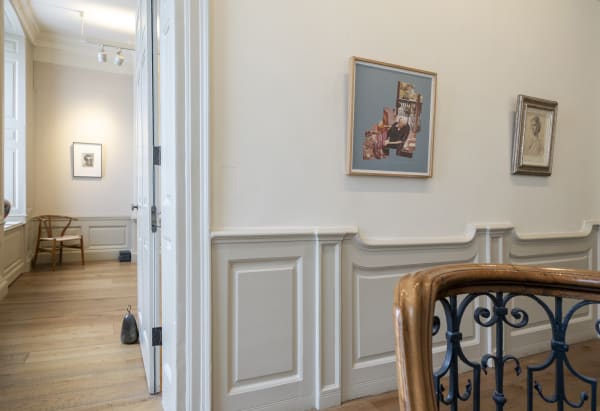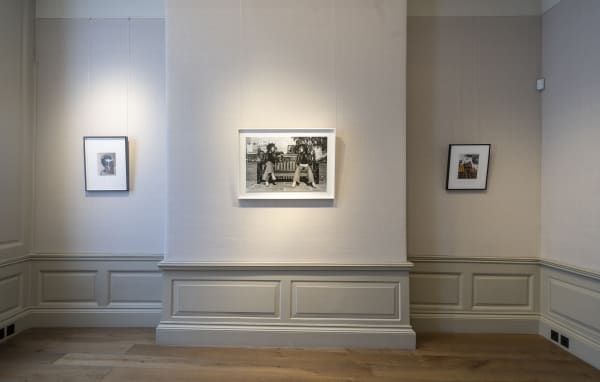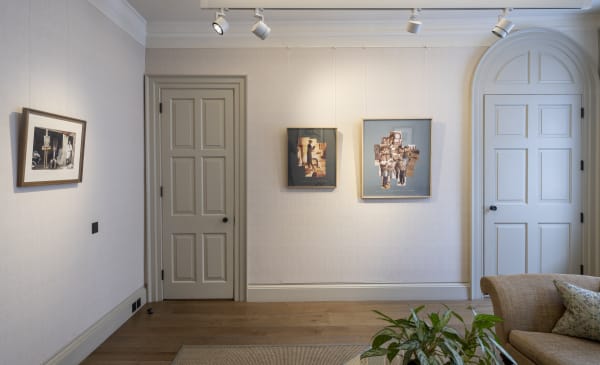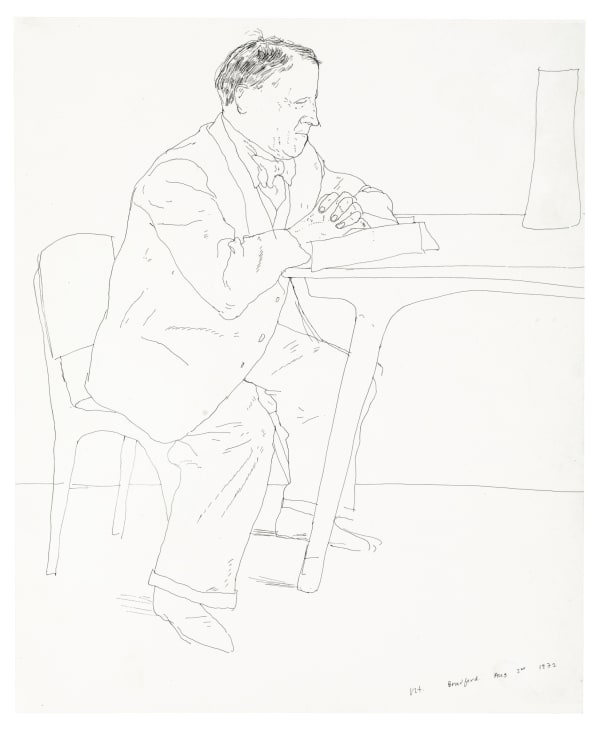Portraits
Open Weekdays 10am - 6pm
This exhibition brings together modern portraits from the gallery’s inventory, with newer works by represented artists and guest artists who are showing with us for the first time. The portraits date from 1907 to the present and encompass photography, printmaking, drawing, collage, painting and ceramics. While each work has been selected for its individual qualities, when brought together certain emotional themes and conceptual strategies emerge, connecting images made in different times and places.
In several pictures the subject is a close relative of the artist. This is unsurprising given that family members are often near at hand and have become tolerant of modelling for their loved ones. We have David Hockney’s affectionate 1972 ink drawing of his father in a bow tie and a more melancholy, yet vividly coloured photo-collage of his mother asleep, made ten years later. Lucian Freud’s daughter Ib has explained how sitting for a picture was the only way she and her siblings got to spend any time with their father, a fact which, once known, adds a feeling of pathos to her portrait; while Tarka Kings’ romantic drawing of her teenage son on a train, commemorates his passage into adulthood.
Other portraits are set in the more professional space of the artist’s studio where paid models might expect to endure increased levels of discomfort. Freud’s etching Man Resting (State II), 1988 shows his model crashed out, face crumpled under the weight of a heavy head. Photos of Freud and Bacon’s studios maintain the mythology of the studio as a heroic space, where paint is wrestled into submission by masterful (male) artists, and yet both artist’s look uncertain and even physically unsteady when the camera is turned on them.
Several of the photographers included here take an experimental approach to the medium. The low angle from which Brandt photographs his nude on a beach, follows an established thread of abstraction in modern photography, but Brandt’s British backdrops offer a more grungy realism than early modernist images originating in Paris and New York. In Hockney’s photo-collages dating from 1982-3 he discovered a new photographic language, analogous to Cubist painting. While Richard Learoyd’s life sized Polaroid print Olya in Yellow, Two, 2010, combines an exceptional level of verisimilitude (as if one might reach into the picture and touch the figure) with a composition indebted to history painting.
The portraits present a range of strong personalities - willing models who have their own need to be seen and heard. The two earliest works in the show are of spirited modern women, both artists, Mary McEvoy (1877-1927) and Iris Tree (1897-1968) one of the first women in London to chop her hair into a bob. The realistic modelling of Augustus John’s 1907 pencil drawing of McEvoy declares her as an equal to the artist, independent of family or husband, although her biography reveals that she gave up her own art for the duration of her marriage.
The process of drawing is foregrounded in many of these portraits. There are many ways to make a drawing and several pictures suggest an intense level of observation and recording. Gallery artist Kings builds up her images using a range of intricate marks. Her unfinished portrait of Lily echoes the delicate coloured pencil in Hockney’s portrait of Mo and the obsessive cross-hatching in Freud’s etchings. John’s beautifully observed drawing of McEvoy is mirrored a century later in Diarmuid Kelley’s portraits, which are always made from life and where a flash of orange, or patch of lilac paint, perfectly captures an ear or eyelid.
Collage and collage processes are a natural vehicle for expressing ideas of duality and fragmentation. Rose Finn-Kelcey’s trick photo, and Perry’s densely decorated pot, each present two images of the artist within one work. By questioning the notion of a coherent self, they raise further questions regarding gender and sexuality, positioning their multiple identities as a strength. In Stezaker and Moretti’s traditionally made collages surreal juxtapositions also disturb the surface of things. Stezaker’s Mask series - where postcards of landscapes are placed over the faces of film stars - suggest the unfathomable forces nature, while Moretti’s collages which splice together gay pin ups and paintings by Picasso are part homage and part critique of the artist’s aggressively heteronormative masculinity.
This event is part of a series of exhibitions across London to celebrate the reopening of the National Portrait Gallery on 22 June 2023. For more information about participating galleries, please visit: PORTRAIT MODE
With thanks to Andree Cooke, Simon Moretti and Tom Rowland.
-

-
 Richard Learoydb.1966Olya in Yellow, Two, 2010signed in black felt tip pen verso and with a gallery label bearing information about the work in facsimile affixed to the back of the frameunique Ilfochrome photograph, flush-mounted onto aluminium48 x 48 inches
Richard Learoydb.1966Olya in Yellow, Two, 2010signed in black felt tip pen verso and with a gallery label bearing information about the work in facsimile affixed to the back of the frameunique Ilfochrome photograph, flush-mounted onto aluminium48 x 48 inches
121.9 x 121.9 cm -

-

-

-
 Grayson Perryb.1960Pseudo Spiritual Clap Trap, 1998glazed earthenware15 x 11 1/8 x 11 1/8 inches
Grayson Perryb.1960Pseudo Spiritual Clap Trap, 1998glazed earthenware15 x 11 1/8 x 11 1/8 inches
38.1 x 28.3 x 28.3 cm -

-

-
 David Hockneyb.1937Artist's Father Reading at Table, 1972initialled, inscribed and dated DH Bradford. Aug 2nd 1972ink on paper16 7/8 x 13 3/4 inches
David Hockneyb.1937Artist's Father Reading at Table, 1972initialled, inscribed and dated DH Bradford. Aug 2nd 1972ink on paper16 7/8 x 13 3/4 inches
43 x 35 cm -
 Lucian Freud1922-2011Man Resting (State II), 1988initialled and numbered IX/X A.P., from an edition of 30 plus 10 APs
Lucian Freud1922-2011Man Resting (State II), 1988initialled and numbered IX/X A.P., from an edition of 30 plus 10 APs
printed by Marc Balakjan at Studio Prints, London
published by James Kirkman, London and Brook Alexander, New Yorketching on paper18½ by 19¾ / 47 by 50.2 cm, sheet size -

-
 Tarka Kings, A Portrait of the Artist's Mother, 2014
Tarka Kings, A Portrait of the Artist's Mother, 2014
